- Home
- News
- What’s On
- Activities for Children
- Arts & Crafts
- Autos and Bikes
- Business events
- Car Boot & Auctions
- Charity events
- Churches & Religious
- Comedy
- Dance
- Days out & Local interest
- Education
- Exhibition
- Film
- Gardening & Horticulture
- Health
- Markets & Fairs
- Music
- Nature & Environment
- Spiritual
- Sport
- Talks and Discussions
- Theatre and Drama
- Business
- Local Information
- Jobs
- Deaths
- Charity events
- Contact Us
Macclesfield’s neo-Palladian masterpiece
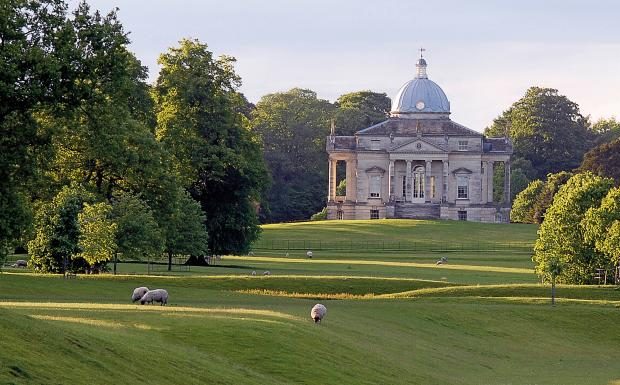
You would never guess from its columns, Henbury Hall was only completed in 1987 and a newly published book – featured in The Sunday Times – tells its fascinating story.
Most people bother new acquaintances with photographs of their children, but Sebastian de Ferranti carried a postcard of Henbury Hall around with him. His widow, Gilly, says she caught him showing it to wedding guests while they were at a lavish affair at a chateau.
“Can you imagine?” she asks, mortified. “We were in this magnificent setting and he says, ‘Have you seen my house?’” She describes her late husband as an “unusual character” who was as besotted with his family’s 500-acre estate on the outskirts of Macclesfield, in Cheshire, as any proud parent would be with their newborn child.
For decades, Sebastian had dreamt about what he could build on the bald spot where his parents had demolished the main house shortly after they bought it in 1957 — dry rot had pushed them into the former stables next door. He finally got his chance in 1982, when he stepped down as chairman of Ferranti, the family electrical engineering firm. Then in his fifties, Sebastian poured his considerable energy and know-how into creating a country home as grand as any period pile.
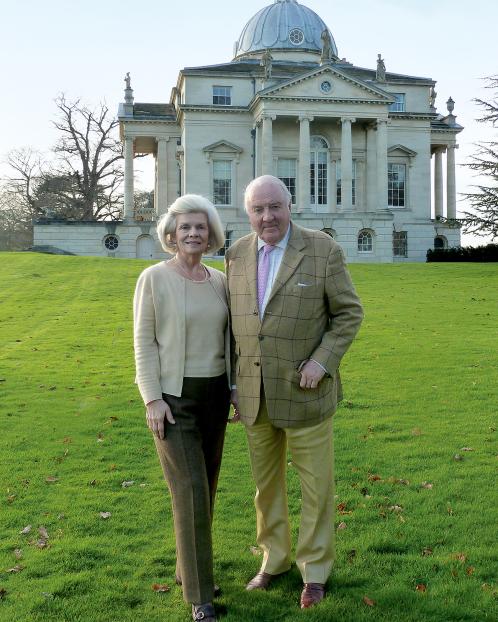
Though you would never guess from its Palladian columns, the main house was completed in 1987. Its symmetrical splendour was inspired by a Felix Kelly painting — a contemporary of Lucian Freud, Kelly gained renown for painting the houses of the rich in the US and the UK. His vision for Henbury couldn’t have been less contemporary: a domed neoclassical Italian villa standing sentinel amid wind-whipped trees and ominous grey clouds.
An Englishman by birth but an aristocratic Venetian by ancestry, Sebastian loved it, and the results, completed with the help of the architect Julian Bicknell, are eerily faithful to Kelly’s original painting, which hangs in the house today. Henbury Hall is a heady fusion of Palladio’s 16th-century villa La Rotonda, near Vicenza, and the domed Castle Howard, in North Yorkshire — like its creator, it blends Italian theatricality and English eccentricity.
Early visitors were impressed, not least the Prince of Wales, who subsequently hired Kelly and Bicknell to work on Highgrove. Sebastian was closer to the Duke of Edinburgh, who has stayed at Henbury Hall with the Queen, but it was Prince Charles who laid the foundation stone, although he broke off a small piece with a wooden gavel as he did so.
The mishap is immortalised in a Latin inscription on the block and in HRH’s foreword for a new book, Henbury Hall: An Extraordinary House. “[It] represents Sebastian’s single-minded dedication to what he believed in — that a house should be an expression of the best design, craftsmanship, decoration and comfort,” Prince Charles writes.
The hefty coffee-table tome is a family history of the Ferrantis — inventors who introduced alternating electrical current and personal computers to Britain — as well as an architectural record of one of the most admired country houses of the 20th century. But it isn’t just an ode to Henbury. It’s also a love letter to the man who built it.
There’s an entire chapter on Sebastian, who is inextricably fused with every aspect of the house. He would often discuss writing a book about Henbury with Gilly, and they would jokingly end conversations with “and we must remember to put that in the book”.
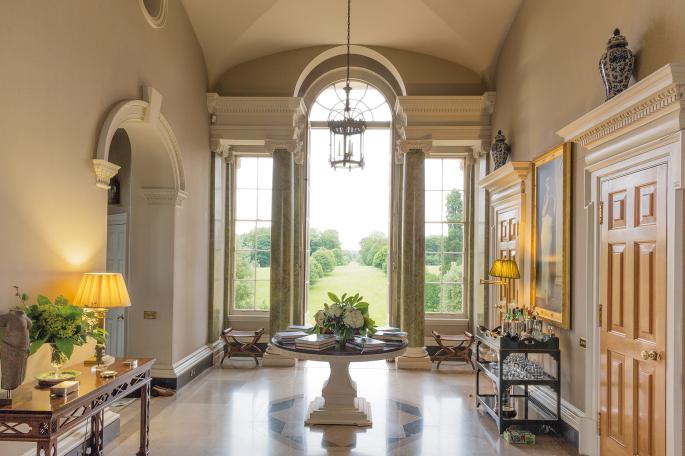
“In truth, we both loved the idea and referred often to ‘our book’, which became a mythical entity shimmering somewhere in the future,” Gilly writes in her own foreword. After Sebastian’s death from cancer in 2015, aged 88, the material for it festered in a folder until Gilly contacted Jeremy Musson, a journalist who had written an article about the house back in 2011. “It was helpful for Jeremy to have met Sebastian,” Gilly says. “I don’t think I could have written the book otherwise,” Musson says.
It’s easy to be awestruck by the ceilings of the piano nobile that stretch up to the crowning dome, the endless spiral staircases and the imposing Venetian marble columns, but humour lives in the details. A novelty figurine of the Queen waves at guests from a side table in the sitting room, while an embroidered fox skirts across a cushion opposite. Most mischievously of all, an original John Ferneley fox-hunting painting takes pride of place over the buffet in the dining room — but it is the Ferrantis who gaze out. Sebastian had himself, resplendent on horseback in a scarlet coat, painted into the scene by the artist John Ward, along with members of his family. “Some people are horrified by it, but Sebastian loved to shock people,” Gilly says.
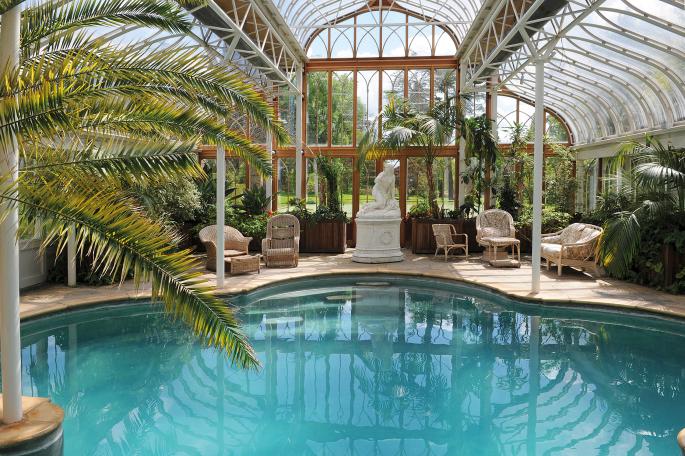
Yet he could also be a stickler for tradition. Once, she asked if he wanted breakfast in the kitchen, rather than in the Murano-glass-chandeliered dining room. He refused, remarking that it would be the “beginning of the end” if they did.
Despite its grand appearance, the main house has only four modestly sized bedrooms. “I’m told they should be bigger, but to keep the symmetry of the house, you’d have to make the whole thing bigger and it would just get ridiculous,” Gilly says. It’s a home that blends utility and beauty with apparent ease. Next to an elaborately mirrored lift, there’s an ingenious gold stand that folds flat against the wall, “for people to put food trays and cups of tea on — you know the sort of thing”, Gilly says.
Sebastian hired craftsmen at the top of their trade to work on the finer details and took a deep interest in their work. “He was a hard taskmaster, very exacting,” she says. “He was an engineer, so he wanted to know how it all worked.” Much of the cast stonework and woodcarving — there’s gilding around the house’s ornately embellished doorframes, and Roman goddesses are carved into its marble fireplaces — was handmade by Dick Reid, a craftsman from York who went on to work for the Rothschilds at Spencer House, in London. The interiors were designed by David Mlinaric, who has worked at the Royal Opera House and the V&A. Kelly was re-enlisted to transform the Cave, a dilapidated farmhouse that’s now pretty in pink, with gothic windows, and let to a family.
Other treasures were acquired, including the tub in the master bathroom, a six-tapped contraption with copper and gold pipes that looks like something Dick Van Dyke might have invented in Chitty Chitty Bang Bang. Bought from the Dowager Marchioness of Cholmondeley, it is an engineer’s bathtub if ever there was one.
The pattern for the silk curtains in the drawing room, hazy red and green flowers, is called Mme Royale: it was created for Marie Antoinette. “The factory in France was still there, so we got them made up,” Gilly says, joking “They’re very Cheshire, aren’t they?” as she admires the leopard-print edges.
Now 73, she lives in the house by herself, but she is hardly ever alone. A handful of staff live in the grounds, and children, grandchildren and old friends are always asking if they can drop in for a night or two. When the main house fills up, guests spill over into Tenants Hall, the former servants’ quarters where Sebastian’s parents once lived. These days, it also acts as a tearoom when Henbury Hall opens its grounds to curious guests, which it does a few times a year.
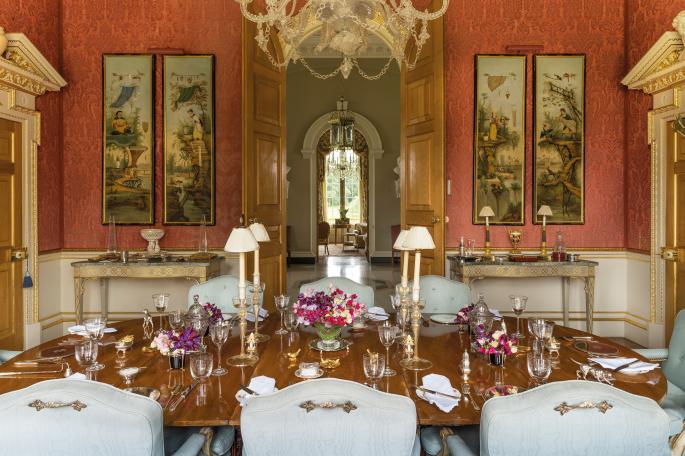
The gardens are where Gilly has made her mark. She knew about the house when she and Sebastian were friends, and it was finished by the time they got married in 2011. “If I had known I would be living in it eventually, I would have had much more of a say in what was going on,” she says.
Long before Gilly got her hands on the grounds, it was the Victorian silk manufacturer Thomas Brocklehurst who made the biggest impact. A prolific traveller, he planted flowers and trees from all over the globe, including towering sequoias and Chinese rhododendrons. He also installed a bell that he had bought from a Japanese monastery. More controversially, Brocklehurst is also said to have brought grey squirrels to Britain.
Gilly, who worked for many years as a landscape gardener, set to work introducing long grasses to the overly manicured 12-acre gardens and put the greenhouses to good use, growing peaches, carnations and cyclamen. She visits them most days on her walking route through the Little Garden, past the two lakes, down the avenue of lime trees, up to the walled garden, passing the pool house and tennis court, then crossing the striking scarlet Chinese bridge installed by her late husband, before arriving back at her unique, eccentric, extraordinary house. “A dream manifested,” she says, “and a powerful response to the unnecessary ugliness of much modern architecture.”
Henbury Hall: An Extraordinary House by Jeremy Musson is published on September 19 (Pimpernel Press £50)
Source: https://www.thetimes.co.uk/edition/home/a-neo-palladian-macclesfield-masterpiece-s8n79vx2r

You must be logged in to post a comment Login